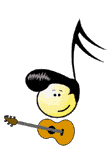
| Pages | 1 | 2 | 3 | 4 |
would get used to it, but it's far more interesting to have variations in color.
The same is true for chords in a song. It's much better to have several ways to play the same
chord. We have a number of options to introduce variety. This is an exciting area to study, but it
can get complex quickly.
I'll introduce you to the various ideas. Read them over, but don't get lost here.
Warning - If this is the first time you've seen the following concepts, they may seem confusing at
first. Remember, you can write strong songs with simple chords too.
(I will illustrate some of the concepts with keyboard chord diagrams, but there are too many
possibilities now for me to draw them all. At some point you may wish to find a book of chord
diagrams for keyboard or guitar.)
Are you ready?
Adding Interest
1. Chord Inversions
2. Slash Chords
3. Chord Variations
4. Seventh Chords
5. Altered Chords
6. Chord Substitutions
7. Secondary Chords
1. Chord Inversions
Suppose you are playing a simple D chord. You look down at your hand and notice you are
playing three notes: a D, an F#, and an A. You ask -"What would happen if I let go the D note
and replaced it with another D further up the keyboard?" You would still have a D chord, but it
would be a different arrangement of the three notes.
The idea here is: As long as you are playing a D, an F#, and an A, regardless of where they are
located on the instrument, you are playing a D chord.
Here is a picture showing the D chord with two inversions.
Did you notice that the middle chord, D/F#, has only two notes in the right hand? This is
intentional. When the "third" of the chord is in the bass, it often sounds best to leave the "third"
out in the right hand. (F# is the "third" of the chord because the D scale goes D, E, F#...)

Do you see how the same three notes are involved? They just show up in different places.
2. Slash Chords
Until now, every time we showed a D chord, the bass note was always a D. What would
happen if we played the F# or the A instead? We would still be playing a D chord, but changing
the bass note makes a big difference. It makes such a big difference that we have a way of
indicating when we want the bass note to be one of those other possibilities. We call them slash
chords.
When we want a D chord with D in the bass, we write D. When we want the F# in the bass,
we write D/F#. When we want the A in the bass, we write D/A.



Did you notice that the middle chord, D/F#, has only two notes in the right hand? This is
intentional. When the "third" of the chord is in the bass, it often sounds best to leave the "third"
out in the right hand. (F# is the "third" of the chord because the D scale goes D, E, F#...)